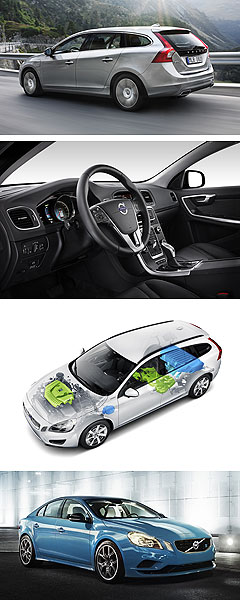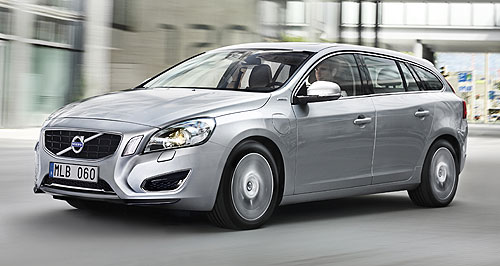Make / Model Search
Future models - Volvo - V60 - Plug-in hybridVolvo set to go green – and blue – in OzA plugger no more: Volvo’s V60 D6 plug-in hybrid wagon can cover the 0-100km/h sprint in 6.2 seconds. Plug-in hybrid wagon and race-bred Polestar sports sedan to reshape Volvo’s image19 Jun 2012 By RON HAMMERTON in GOTHENBURG VOLVO Car Australia (VCA) is set to throw off the cloak of conservatism by introducing two groundbreaking mid-sized vehicles that will make waves for different reasons from next year. In the green corner, Volvo’s first plug-in hybrid V60 wagon looks ripe for a 2013 launch in Australia, while in the blue corner, the politically incorrect, bitumen-tearing 374kW S60 Polestar sports sedan is an almost certain contender in the local market should Volvo give it the go-ahead for series production as expected. The latter was unveiled in concept form in a deceptively demure baby blue paint job at the weekend at Volvo’s home city of Gothenburg, Sweden, by Polestar – Volvo’s motor racing partner and hot-car specialist (see separate story). Today, VCA managing director Matt Braid confirmed that his branch of Sweden’s biggest car-maker had put up its hand for both of the vehicles to provide some spark to the brand Down Under. The most likely of the duo to arrive in Australia first is the diesel-electric V60 plug-in hybrid electric vehicle (PHEV) – dubbed D6 – that will go into production for Europe alongside the standard S60/V60 range in November. Mr Braid described the V60 D6 PHEV and S60 Polestar sedan as niche halo vehicles for the Volvo brand, appealing to small groups of distinct customers.  From top: Volvo V60 D6 plug-in hybrid S60 Polestar. From top: Volvo V60 D6 plug-in hybrid S60 Polestar.Neither car will be cheap, however, with Mr Braid indicating both vehicles will be priced above Volvo’s most expensive current models, which top out at $81,450 (plus on-roads) for the S80 T6 R-Design. He said he expected the V60 D6 to slide into the range at a price premium of about $20,000 over the $67,990 V60 T6 AWD, but it would benefit from a luxury car tax discount of up to $7000 because of its low fuel consumption. The V60 D6 can achieve a class-leading 1.9 litres per 100km on the European official fuel economy combined test cycle, and yet can accelerate from zero to 100km/h in 6.2 seconds – equal with the current fastest V60, the turbocharged T6. By comparison, General Motors’ plug-in Volt manages between 2.5 and 3.9 litres per 100km on the American fuel test, and accelerates to 100km/h in about nine seconds. Mr Braid said his company had started seriously looking at importing the V60 Plug-in Hybrid after showing the car in concept form at the Australian International Motor Show in Melbourne last year. He said the car had received a warm response from show-goers, and while the market for such a car would be small, it would provide a halo effect for the Volvo brand. “For us, this car will demonstrate the technology, as a niche model, and halo model,” he said. “Volumes won’t be massive.” Mr Braid said now that Volvo was to put the vehicle into production – and likely becoming the first diesel-electric plug-in hybrid in the world – VCA was set to put up its hand to import it, hopefully in 2013. He said the V60 D6, which combines a five-cylinder diesel engine driving the front wheels and an electric motor powering the rear wheels, was a better option for Australia than a full-electric car such as Volvo’s C30 DRIVe that has been trialled in a number of countries since last year. Mr Braid said the Volvo leasing system for the electric cars, with a guaranteed buy-back arrangement, would not work in Australia. “We think it is best to kick off with the plug-in V60,” he said. Volvo is set to begin a run of 1000 V60 PHEVs in November, before stepping up to full production of between 4000 and 6000 vehicles from next year. At that volume, the V60 D6 will comprise between 10 and 15 per cent of V60 production. Mr Braid said Australia would have to wait until full production started before it could import the vehicle. He said he still did not know “the sweet spot” for the vehicle’s price, but it would be marketed as a halo model priced somewhere between the $67,990 3.0-litre T6 AWD V60 and $100,000. The V60 D6 is a modified version of the standard V60 D5, with the same 158kW 2.4-litre five-cylinder turbo-diesel engine under the bonnet. However, Volvo has added a 50kW/200Nm electric motor to the rear axle, powered by a lithium-ion battery that can be charged in between 3.5 hours and 6.7 hours, depending on the amperage. Using a standard 10-amp household 240-volt socket, the full charge takes 4.5 hours. Dubbed the D6 in recognition of its D5 engine and electric motor, the vehicle can drive for up to 50km at 100km/h on battery power alone before the diesel engine kicks in to extend the range to a total 1000km. Three driving modes govern the powertrain. The default mode is Hybrid, which starts the vehicle off on electric power driving through the rear wheels, but the diesel engine kicks in via the front wheels if the driver accelerates firmly. Two other modes are available at the press of a button on the console – Pure (for pure electricity) and Power. While the former holds electric mode at speeds of up to 120km/h, the latter draws performance from both powertrains for a total of 208kW through all four wheels. A few laps of Volvo’s factory test track proved the V60 D6 not only operates seamlessly through all the modes as promised, but with surprisingly sprightly performance. While we could not manage a 6.2-second 0-100km/h sprint, we did do a sharpish 6.5-second run. The only hint of the diesel engine’s intervention was the familiar rattle from under the bonnet, but not intrusively. The hefty weight of the vehicle – circa 1800kg, courtesy of the batteries and extra motor – was evident through corners, but the all-wheel-drive mode kept the vehicle surefooted. Inside, the V60 D6 is swathed in leather as befits its role as V60 flagship, and even has a few new touches from the upcoming V40 small car, including the automatic transmission shift lever knob and switchgear. In the back, the floor of the wagon luggage area has been raised 60mm to help accommodate the batteries and motor, costing some of the cargo capacity. Fuel tank capacity has been cut to 45 litres to help make way for the electric hardware. A petrol version is being developed for markets where diesel is not fancied, such as China and the United States, although Volvo says it has not been formally signed off for production. The Volvo hybrid powertrain is similar in concept to PSA Peugeot Citroen’s Hybrid4 hybrid set up that also applies diesel power to the front wheels and electric motivation to the rear wheels.  Read more19th of June 2012  Volvo developing XC90 plug-inNext-gen Volvo XC90 to get alternative diesel-electric hybrid powertrain17th of June 2012  Volvo looking for a blue with S60 PolestarStonking 374kW Volvo S60 Polestar concept lays down the challenge to German rivals15th of December 2011  Plug-in diesel-electric Volvo delayed for Oz until 2014Volvo V60 plug-in diesel hybrid still more than two years from local debutAll future models Alfa Romeo Alfa Romeo Abarth Abarth Alpine Alpine Alpina Alpina Audi Audi Aston Martin Aston Martin BMW BMW Bentley Bentley Chery Chery Brabham Brabham Chrysler Chrysler Chevrolet Chevrolet Cupra Cupra Citroen Citroen DS DS Dodge Dodge Fiat Fiat Ferrari Ferrari Foton Foton Ford Ford Great Wall Great Wall FPV FPV Haval Haval GWM GWM Honda Honda Holden Holden Hummer Hummer HSV HSV Infiniti Infiniti Hyundai Hyundai Jaguar Jaguar Isuzu Isuzu Kia Kia Jeep Jeep Land Rover Land Rover Lamborghini Lamborghini Lexus Lexus LDV LDV Mahindra Mahindra Lotus Lotus Mazda Mazda Maserati Maserati Mercedes-AMG Mercedes-AMG McLaren McLaren MG MG Mercedes-Benz Mercedes-Benz Mitsubishi Mitsubishi Mini Mini Opel Opel Nissan Nissan Peugeot Peugeot Pagani Pagani Proton Proton Porsche Porsche Renault Renault Ram Ram Rover Rover Rolls-Royce Rolls-Royce Skoda Skoda Saab Saab SsangYong SsangYong Smart Smart Suzuki Suzuki Subaru Subaru Toyota Toyota Tesla Tesla Volvo VolvoV60 pricing
Motor industry news |
Click to shareVolvo modelsResearch Volvo All future models Alfa Romeo Alfa Romeo Abarth Abarth Alpine Alpine Alpina Alpina Audi Audi Aston Martin Aston Martin BMW BMW Bentley Bentley Chery Chery Brabham Brabham Chrysler Chrysler Chevrolet Chevrolet Cupra Cupra Citroen Citroen DS DS Dodge Dodge Fiat Fiat Ferrari Ferrari Foton Foton Ford Ford Great Wall Great Wall FPV FPV Haval Haval GWM GWM Honda Honda Holden Holden Hummer Hummer HSV HSV Infiniti Infiniti Hyundai Hyundai Jaguar Jaguar Isuzu Isuzu Kia Kia Jeep Jeep Land Rover Land Rover Lamborghini Lamborghini Lexus Lexus LDV LDV Mahindra Mahindra Lotus Lotus Mazda Mazda Maserati Maserati Mercedes-AMG Mercedes-AMG McLaren McLaren MG MG Mercedes-Benz Mercedes-Benz Mitsubishi Mitsubishi Mini Mini Opel Opel Nissan Nissan Peugeot Peugeot Pagani Pagani Proton Proton Porsche Porsche Renault Renault Ram Ram Rover Rover Rolls-Royce Rolls-Royce Skoda Skoda Saab Saab SsangYong SsangYong Smart Smart Suzuki Suzuki Subaru Subaru Toyota Toyota Tesla Tesla Volvo VolvoV60 pricing
Motor industry news |











Facebook Twitter Instagram